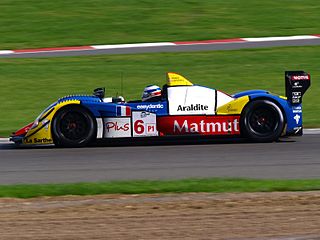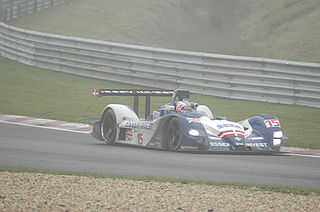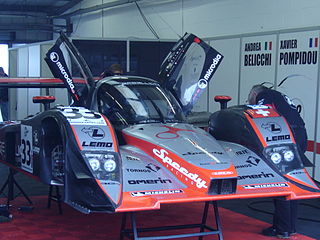Lola Cars International Ltd. was a British race car engineering company in operation from 1958 to 2012. The company was founded by Eric Broadley in Bromley, England, before moving to new premises in Slough, Buckinghamshire and finally Huntingdon, Cambridgeshire, and endured for more than fifty years to become one of the oldest and largest manufacturers of racing cars in the world. Lola Cars started by building small front-engined sports cars, and branched out into Formula Junior cars before diversifying into a wider range of sporting vehicles.

The Audi R8 is a Le Mans Prototype sports-prototype race car introduced in 2000 for sports car racing as a redevelopment of their Audi R8R and Audi R8C used in 1999. In its class, it is one of the most successful racing sports cars having won the 24 Hours of Le Mans race in 2000, 2001, 2002, 2004, and 2005, five of the six years it competed in total. Its streak of Le Mans victories between 2000 and 2005 was broken only in 2003 by the Bentley Speed 8, another race car fielded that year by Volkswagen Group.

Judd is a brand of racing car engines built by Engine Developments Ltd., a company founded in 1971 by John Judd and Jack Brabham in Rugby, Warwickshire, England. Engine Developments was intended to build engines for Brabham's racing efforts, and became one of the first firms authorised by Cosworth to maintain and rebuild its DFV engines, but has since expanded into various areas of motorsport.

The 2006 24 Hours of Le Mans was the 74th Grand Prix of Endurance, and took place over 17–18 June 2006. The winners of the race were Frank Biela, Marco Werner, and Emanuele Pirro, driving the Audi R10 TDI. For the first time in the history of the race, the winner was a diesel-powered car.

Courage Compétition was a racing team and chassis constructor company now owned by Oreca, based in Le Mans, France near the Circuit de la Sarthe. It was founded by Yves Courage, a French race driver who ran hillclimbs before founding the company. Following the purchase of Courage by Oreca in 2007, Yves Courage has refounded the company as Courage Technology in 2010, attempting to develop electric racing cars.

The BMW V12 LM was a racing car built for sports car racing in 1998. The car was built using a combination of WilliamsF1 chassis engineering and construction and a BMW powerplant. The car was a predecessor to the BMW V12 LMR, which debuted in 1999.

The Acura ARX-01, later known as the HPD ARX-01 is a series of Le Mans Prototype built for sports car racing, specifically in the American Le Mans Series, Le Mans Series, and at the 24 Hours of Le Mans. It is the first purpose-built race car by the Acura division of Honda Motor Company, part of their multi-year program to eventually compete in endurance race. The car debuted in 2007 in the American Le mans Series before expanding to customers in Europe. Over the years various specifications of the ARX-01 chassis have been developed, each signified by a letter suffix. In 2010 Acura withdrew their name from the program and Honda Performance Development which developed the car for Acura continued the program into 2011.

The Lola T92/10 was a Group C sports car developed by Lola Cars as a customer chassis for the 1992 World Sportscar Championship season. It would be the final sports car built by Lola until their return in 1998.

The MG-Lola EX257 is a Le Mans Prototype built by Lola for the MG car company for their attempt to compete again at the 24 Hours of Le Mans in 2001. The car has had many years of mixed success since its introduction, even in privateer hands.

The Lola B98/10 was a Le Mans Prototype built by Lola Cars International for use in the International Sports Racing Series, American Le Mans Series, and 24 Hours of Le Mans. It would be the first international sports car built by Lola since they briefly left the sport in 1992 following the Lola T92/10. It would be succeeded in 2000 by the Lola B2K/10.

The Lola B2K/40 was a Le Mans Prototype developed in 2000 by Lola Cars International as a cheaper, smaller, and lighter alternative to the similar Lola B2K/10. Although specifically designed to compete in the SR2 class of the Sports Racing World Cup and Grand American Road Racing Championship, it would later be adapted to the LMP675 and LMP2 classes for the 24 Hours of Le Mans and American Le Mans Series. This design was replaced in 2005 by the Lola B05/40 and would last be used in competition in 2006.

The Lola B05/40 is a Le Mans Prototype built by Lola Cars International for use in the LMP2 class for the American Le Mans Series, Le Mans Series, and 24 Hours of Le Mans. Developed in 2005, it was intended as a replacement for both the Lola B2K/40 and the MG-Lola EX257. It shares various structural elements with the larger LMP1-class Lola B06/10.

The Lola B06/10 is a Le Mans Prototype developed by Lola Cars International for use in the LMP1 class of the American Le Mans Series, Le Mans Series, and 24 Hours of Le Mans. It was developed in 2006 as a replacement for the Lola B2K/10 as well as the MG-Lola EX257. It shared much of its mechanical elements and design with the LMP2 class Lola B05/40, which was developed the year prior.

The Lola B08/60 is a Le Mans Prototype built by Lola Cars International. It is the first closed-cockpit sports prototype built by Lola since the 1992 T92/10. It started competition in 2008, with Aston Martin being among the first customers for their entry into the LMP1 category in Le Mans Series, albeit entering under Charouz Racing System banner.

The Chevrolet Corvette GTP was an American Grand Touring Prototype-class sports prototype racing car which successfully participated in the IMSA Camel GT from 1984 until 1989. The car was professionally fielded in competition as General Motors' Chevrolet Corvette C4 official factory team effort in the IMSA GTP class.

The Reynard 02S was a Le Mans Prototype race car built by Reynard Motorsport in 2002. Intended to replace the failed Reynard 2KQ prototype, the 02S would end up becoming the final new design from Reynard as the company went bankrupt prior to the project's completion.

The Lola B08/80 is a Le Mans Prototype built by Lola Cars International. It is effectively the LMP2 version of the larger Lola B08/60; they are the first closed-cockpit sports prototypes built by Lola since the T92/10 of 1992. The B08/80 is optimised for the smaller engines and lighter weight of the LMP2 category in comparison to the larger and heavier B08/60.

The Riley & Scott Mark III was a sports prototype auto racing car developed by Bob Riley, Bill Riley, and Mark Scott of Riley & Scott Cars Inc. Initially designed in 1993, the car was created for the World Sports Car (WSC) category which was to debut in the North American IMSA GT Championship during their 1994 season. It was not until 1995 that the first Mk III was completed, but the construction of further cars allowed a variety of teams to campaign in several North American and European racing series, including competing at the 24 Hours of Le Mans.
Intersport Racing is a former American auto racing team founded by Jon Field. The team was based in Dublin, Ohio. They previously operated two Oreca FLM09 sports cars in the American Le Mans Series. At current, the company has transitioned into diet supplements.
Crawford Composites is an American manufacturer of carbon fiber and composite parts company based in Denver, North Carolina. Crawford designs and manufacture structural and non-structural composite components in industries such as aerospace, aviation, motor sports, health care, defense and structural construction.

















